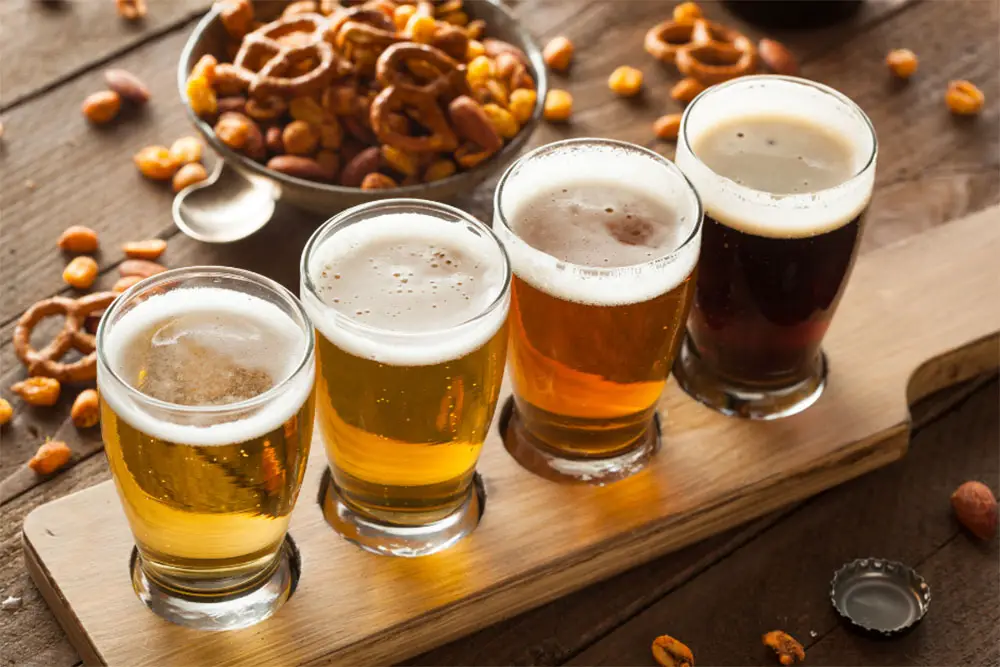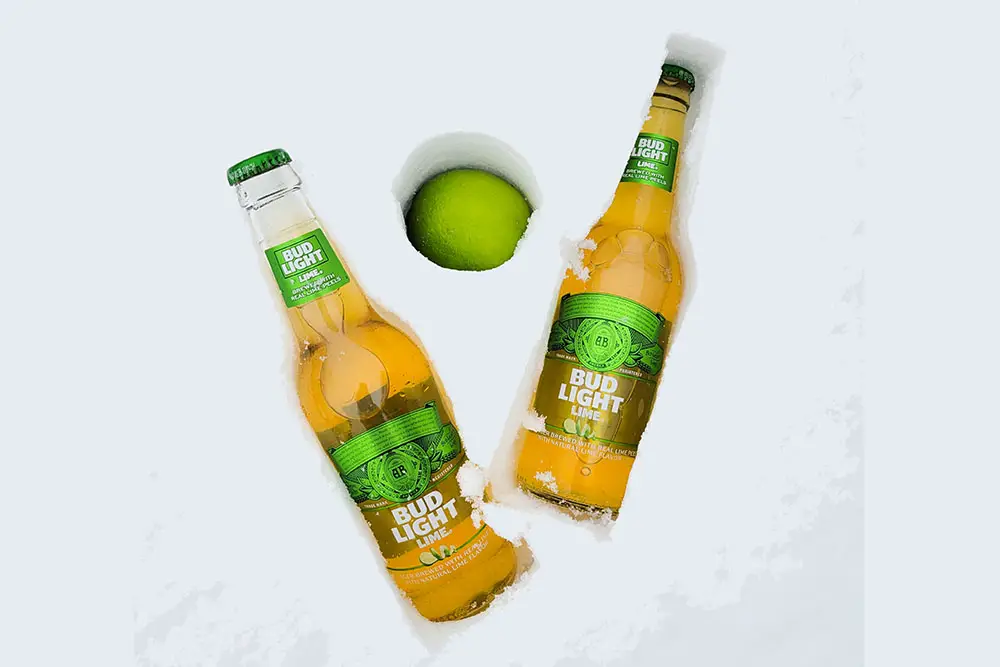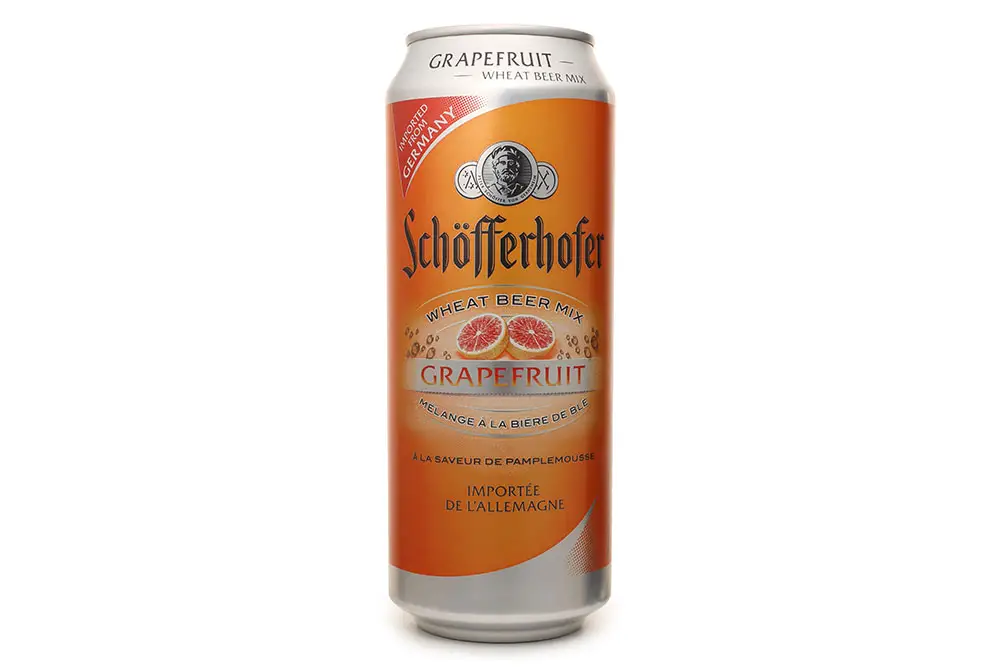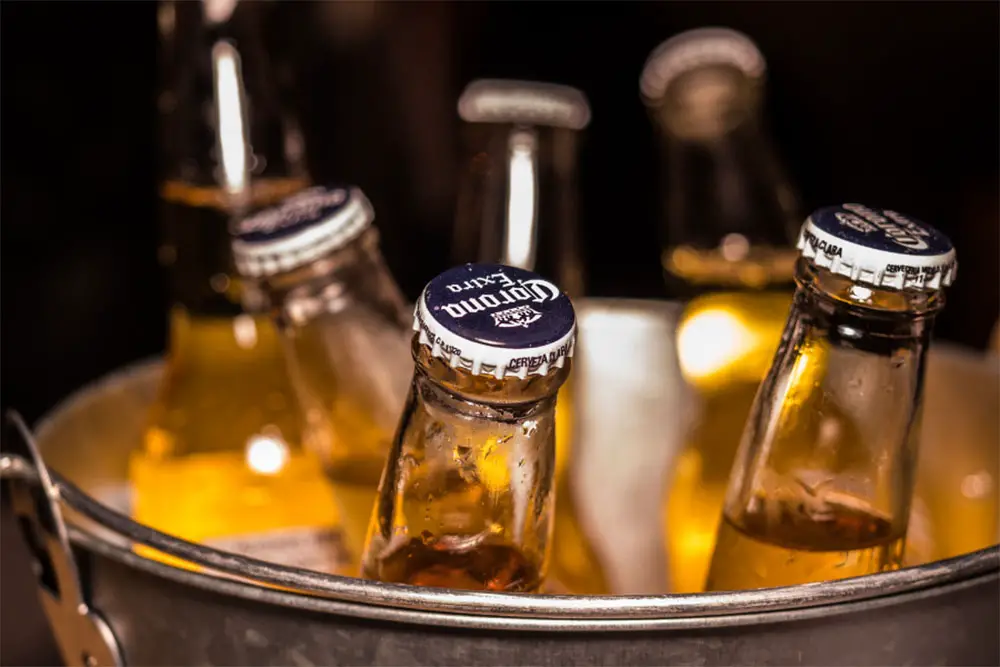Whether you’re interested in homebrewing or you’re a craft beer enthusiast, one thing you’ll find when it comes to beer is that there are many different terms to learn. One of the most confusing of these is “sweet” beer.
Most people wouldn’t want their beer to taste sweet, right? So how come sweet beer is so popular? And what even is sweet beer?!

BEER DROP: Boxes of beer from Award-winning microbreweries → Join The Club
If you’ve ever found yourself asking these questions, you’ve come to the right place! Below, we’ll take an in-depth look at sweet beer. We’ll look at what it is, what makes it sweet, and discuss the differences between sweet and fruity beers. We’ve even collected a list of the best sweet beers on the market.
What Is Sweet Beer?
Let’s cut straight to the chase. Put simply, sweet beer is a beer that doesn’t have too much of a “beer taste”. It’s brewed just like any other beer would be, it’s just milder and smoother. It may also feature some ingredients that add extra sweetness into the mix such as limes, oranges, and even chocolate!
The term “sweet beer” can also apply to different types of beer including lager, ale, and pale ales. The only thing that separates it and gives it the terminology of “sweet beer” is that it doesn’t have that classic beer taste.
The Best Sweet Beers
Below, we’ll take a look at some of the best sweet beers available. Some of these you’ll have heard of and you might even have sampled, while others will be brand new to you. The main thing to remember here, however, is that they all fall into the sweet beer category.
Bud Light Lime
Bud Light Lime is one of the most popular sweet beers in the world. In fact, when it was first launched in 2008, the sales for Bud Light Lime were so high it was referred to as “the atomic bomb in the marketplace”.

It’s a light, pale lager with a 4.2% ABV. The sweetness it holds comes from the limes used in the brewing process, and it has a refreshing taste that isn’t dissimilar to soda. This makes it an excellent choice for anybody that doesn’t particularly like the taste of beer, but would still like to be able to relax with a chilled bottle on a hot day.
Bud Light Orange
While almost everybody loved the taste of Bud Light Lime, Bud Light Orange didn’t see quite the same instant rise in popularity and it was launched in 2018 to heavily divided opinions. However, over the years, it’s become an increasingly popular drink with people who don’t enjoy the taste of beer.
Its sweetness comes from the orange peel it’s brewed with, and you can taste the citrus flavor with every mouthful. This doesn’t mean it’s overwhelming though, and this 4.2% ABV pale lager has a subtler sweetness than its predecessor.
Blue Moon Belgian White
You may be surprised to find Blue Moon Belgian White on a list of sweet beers but, when you look at the flavor notes and the ingredients used to create it, there’s no denying that it has a certain level of sweetness to it.
It has a 5.4% ABV and is brewed with Valencia orange peel and coriander, which is where the subtle sweetness and citrus notes come from. It also has a slightly spicy, peppery flavor that further dilutes the classic beer taste without killing it completely.
Blue Moon Belgian White is an excellent choice for anybody who likes the mouthfeel of beer but wants something a little sweeter, but not too sweet. It’s kind of like the goldilocks of the sweet beer world!
Dundee Original Honey Brown
This is a red lager with a 4.5% ABV. It has a light, delicate smell to it and the aroma is the first part where you’ll pick up on its sweetness. As you may have guessed from its name, this beer gets its sweetness from the honey used in the brewing process.
This doesn’t only add sweetness to it, though. The honey also helps to give it a rich, bold flavor without being too overpowering. The texture is smooth as well, making it a highly palatable option for anybody looking for something a little sweeter.
Schofferhofer Hefeweizen Grapefruit
Most beer purists would excommunicate anybody who even thought about putting grapefruit in beer. But, the result is a well-made, extremely drinkable sweet beer. There’s no denying that the flavor here is sharp and almost cloying, but this is kind of what you’d expect from grapefruit juice and peel.

Before you even raise the glass to your lips, you have a clear indication of how sweet this beer is through color alone. This is a bright orange beer that doesn’t look dissimilar to a glass of orange soda.
The sweetness here isn’t unpalatable, though. In fact, the acidity of the grapefruit helps to balance things out and provides a distinct citrus flavor.
DuClaw For Pete’s Sake – Imperial Chocolate Peanut Butter Porter
Some beers label themselves as chocolate stouts but, when you take a sip, you’re left wondering where the chocolate actually is. This isn’t the case with this beer. It really does taste of both chocolate and peanut butter, making it the perfect beer for anybody with a particularly sweet tooth.
It is strong and has a 9% ABV but, despite this, it’s very drinkable. There isn’t much beer flavor present either, making it a good choice for anybody that dislikes the taste of beer. It’s worth approaching with caution though, as its drinkability and sweet flavor could result in sinking a few too many!
Hoegaarden Original White Ale
Hoegaarden Original White Ale is pretty close in flavor and texture to Blue Moon Belgian White. It’s slightly weaker with a 4.9% ABV, but it’s brewed using pretty much the same ingredients including orange peel, cilantro, and spices.
It does, however, far out date Blue Moon. It took over 500 years of work and attention to detail to perfect. Some of the ingredients used in its original recipe even included herbs that monks had to import from Curacao.
Flavor-wise, this beer has sweet and sour notes with subtle hints of citrus. It’s also yellow in appearance and has a cloudy finish with a soft foam. If you’re into sweet beers, this is one that you’ll definitely want to try.
Kronenburg 1664 Blanc
Launched in 2006, Kronenburg 1664 Blanc is now one of the most popular wheat beers in France. While it’s brewed in the style of Belgian wheat beer, it has its own flavor and aroma profile that include subtle hints of sweetness.
This naturally cloudy, golden-white beer is a perfect mixture of sweet and sour. Citrus, fruity notes linger on the tongue and these don’t only make it perfect for anybody who enjoys sweet beer, but also makes it the perfect summertime drink.
Corona Extra
Corona Extra is one of the most recognizable beers in the world. In fact, it’s the number one best-selling import in the United States, and it’s pretty clear to see why.

This American-style pale lager has a 4.6% ABV and it tastes sweet without being overly tart. If you’ve ever had this beer before, you’ll know that it comes served with a lime, and this enhances the natural sweetness of the beer. This garnish also gives you the opportunity to add more sweetness if desired.
If you’re looking for a light, sweet, summertime beer then Corona Extra is definitely one to add to your list of “must-tries”!
Samuel Smith’s Organic Chocolate Stout
We’re finishing our list of the best sweet beers with another chocolate stout, this time from Samuel Smith. This beer is brewed by Samuel Smith’s Old Brewery, which is an independent brewery located in North Yorkshire, England. This is also the oldest brewery in the county, founded in 1758.
But what does the beer taste like? The best way to describe it is as chocolate milk for adults. It’s smooth, creamy, and it’s incredibly easy to pick up on the chocolate and vanilla notes, which is where it gets its sweetness from.
There are other flavor notes apart from chocolate and vanilla, though. It also has hints of coconut, cherries, and roasted floral hops. It’s very drinkable too and has a 5% ABV.
This beer is an excellent choice for anybody who would like to try a stout but doesn’t want the bitterness usually associated with this type of beer.
The Best Fruity Beers
That’s sweet beer taken care of, but what about fruity beers? The same terminology applies here. Fruity beers are beers that taste less like beer and more like, well, fruit. They aren’t as popular or widespread as sweet beers, but there are still some excellent choices out there, some of which we’ll look at in more detail further down the page.
The main takeaway here is this: fruity beers and sweet beers kind of do the same thing. Each is designed to deliver different flavor notes while diluting the classic beer taste. The main thing that separates them is the ingredients used in the brewing process. Sweet beers rely on limes, lemons, oranges, and chocolate. Fruity beers use a much wider variety of fruit.
Sonoma Tart
One of the best fruity beers on the market at the moment is Sonoma Tart. This is a deep, cloudy-yellow beer with a long-lasting white head. The aroma features hints of passion fruit and guava, while the flavor consists of mango, candied orange, pineapple, and guava.
This is a very well-balanced fruit beer and, even though it’s technically classed as such, it’s not overly-fruity like some of its competitors. It also doesn’t completely kill the beer taste, so there’s no risk of forgetting what you’re drinking!
Frambozen
If you want to try a very fruity beer but you’re not sure where to start, you can’t go wrong with Frambozen. This has some really dominating fruit flavors including raspberry and burnt orange. It also creates almost no head when poured, and bubbles rise continuously from the bottom of the glass.
Be warned, though. We aren’t joking when we say that the dominating flavor here is raspberry and you’ll need to enjoy a certain level of tartness. However, despite this, the raspberry doesn’t entirely overpower the taste of the beer. Think of it as a perfectly balanced hybrid between raspberryade and a pale lager.
Hanssens Oude Kriek
Right from the moment this beer is poured, the aroma profile is clear. You’ll get notes of almond and ripe cherry, which deliver a gentle sourness. This carries through to the flavor as well and you’ll get dark cherry, dry almond, and subtle sour taste.
Appearance-wise, Hanssens Oude Kriek is a deep red, almost rusty color with a small lacy head. Its aroma, flavor, and appearance all become deeper the longer it’s left to age as well.
What Is Sweet Ale?
Believe it or not, there is a difference between sweet beer and sweet ale, and it all comes down to the brewing process.
Ale is a type of beer, but it’s brewed using a warm fermentation method. This results in a full-bodied, naturally sweeter taste. It’s for this reason that, in general, most ales are sweeter than any other type of beer. It also has less of a naturally “beer-like” taste than any other type of beer.
How Do You Make Beer Sweet?
There are a few reasons why somebody might prefer a sweet beer to a regular beer. Some don’t like the taste of beer, but would still like to be able to drink it. Others simply want to add a little sweetness to their beer in a bid to balance out the bitterness.
But how do you make beer sweet? It’s not a simple case of adding a few spoonfuls of sugar and stirring everything together! In fact, doing this will simply increase the alcohol content as the yeast consumes the sugar.
Instead, sweetness is added to be in one of the following ways:
1. It’s Boiled For Longer
Beer is boiled during the brewing process and, when this happens, a chemical reaction known as the Maillard reaction occurs. This isn’t unlike caramelization which, as you can imagine, adds a certain amount of sweetness to the beer. The longer it’s boiled for, the longer the Maillard reaction goes on, and the sweeter the beer becomes.
2. Caramel Malt
Another way of adding sweetness to beer is by using a caramel malt. However, this should be done with caution as adding too much can make the beer turn overwhelmingly sweet.
3. Unfermentable Sugar
Since caramel malt needs precise measurements and close monitoring, most breweries will use unfermentable sugar to add sweetness to some of their beers. Lactose sugar is the most popular of these, and it’s also a key ingredient in a milk stout.
How To Make Pineapple Beer
If you want to try making your own sweet or fruity beer at home, one of the best ingredients to use is pineapple. It’s also pretty straightforward and, even if you’re new to home brewing, you should find it a pretty easy process.
Here’s how to make pineapple beer at home:
Equipment
- 25 liter container / fermentation tank
- Blender
- Measuring cup
- Funnel
- Cutting board
- Sharp knife
- Several 2-liter plastic drinks bottles
- Hydrometer
Ingredients
- 600g fresh pineapple
- 4kg refined white sugar
- 22L hot water
- 2 x 20g packets of Brewer’s yeast
Method
- Start by cleaning and sterilizing all of your equipment. This is best done by placing it in the dishwasher with no other items. You also need to sterilize your cutting board and work surface.
- Once everything is clean and there isn’t any residual soap left behind, remove the crown and leaves from your pineapple, leaving the peel in place. Chop the pineapple and place the pieces in a blender, making sure you scrape in any juice that remains on the cutting board.
- Add 500ml of boiling water to the blender, and pulse gently until it has a smooth texture. This will take a few minutes, so you’ll need to exercise some patience.
- Once the pineapple looks like a smoothie, pour it into the fermentation tank. Depending on the size of your blender, you may have to repeat the blending and pouring process several times.
- Add a liter of freshly boiled water to the blender and blitz again. This will help you get every remaining piece of pineapple out of the blender and into your fermentation tank.
- Next, start adding the sugar along with the remaining water. This is best done by adding 10 cups of sugar, followed by 10 cups of water, and so on until you’ve reached the desired level in your fermentation tank.
- Once the mixture inside the tank reaches a temperature of around 77-78ºF (25-26ºC) you can add the yeast. The reason you need to let it cool a bit first is that high temperatures can kill the yeast. Likewise, if it’s too cold, the yeast won’t activate.
- Now, loosely put the cap on your fermentation tank. Don’t be tempted to tighten it as the gasses need to escape during the brewing process. If you prefer, you can take a clean cloth and cover the opening with this, securing it in place with an elastic band.
- Move your fermentation tank to a warm space and leave it for 7 days.
- After this time has passed, you can start bottling up your pineapple beer. Take a bucket or large container and cover the top with some muslin. Secure it in place and pour the mixture through the cloth. This will catch any pieces of pineapple that remain in the tank. Again, you may have to do this in stages depending on the size of your container.
- Take a measuring jug and your funnel and carefully decant the mixture from the container into your plastic bottles. Screw the caps in place and leave the bottles to continue fermenting for a few more days.
That’s all there is to it! One thing you need to note, however, is that you need to let each bottle vent very slowly when the time comes to open one. Slowly unscrew the cap, allowing gas to escape, before completely removing it. Once opened, store your pineapple beer in the refrigerator for best results.
Can You Mix Beer & Coke?
Some alcoholic drinks pair very well with Coke. These include whisky, rum, and vodka. You can even mix equal parts of Coke and red wine to create the Spanish favorite “Calimocho”. But, even though you can mix almost anything with Coke, it doesn’t mean that you should. This is definitely the case for beer!
Of course, personal preference will play a large role here. If you’re a fan of mixing beer with Coke because you like the taste, there’s nothing to stop you from doing it. It’s just not something that is done very regularly, and beer purists will certainly have something to say about it!
Final Thoughts
There you have it, everything you need to know about sweet beer. As you can see, the terminology that surrounds it doesn’t have to be as confusing as some people would have you believe. Sweet beer is simply a beer that has less of a “beer taste”. The same principle applies to fruity beers.
If you’re tempted by the idea of a sweet beer but you’re not sure what to choose, any of the beers we’ve listed and reviewed would make an excellent choice. Or, if you’re a keen homebrewer, you can even try making your own pineapple beer using the recipe above!
